Access the power of your smartphone to capture stunning panoramic action shots. Start by choosing a device with multiple lenses and robust camera features. Master composition techniques like the rule of thirds and leading lines to create visually compelling images. Experiment with motion by using slower shutter speeds and smooth panning. Leverage golden hour lighting and HDR mode for dramatic effects. Stabilize your shots using both hands or a mobile gimbal for crisp results. Don't forget to edit your photos with apps like Snapseed or Lightroom Mobile to enhance colors and contrast. With these secrets, you'll transform ordinary scenes into extraordinary visual stories.
Choosing the Right Smartphone
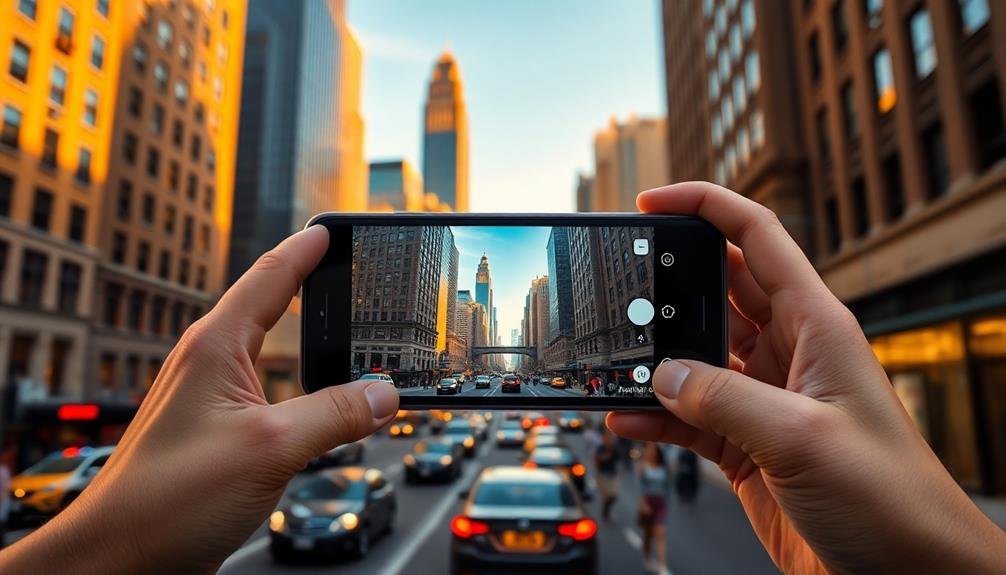
Three key factors should guide your choice when selecting a smartphone for mobile photography: camera quality, software features, and overall performance.
When evaluating camera quality, focus on sensor size, megapixel count, and lens aperture. Larger sensors capture more light, while a higher megapixel count allows for greater detail. A wider aperture (lower f-number) improves low-light performance.
Look for phones with multiple lenses, including wide-angle and telephoto options, to expand your creative possibilities.
Software features like night mode, portrait mode, and pro controls can greatly enhance your photos. Take into account devices with AI-powered scene recognition and automatic adjustments for easier shooting.
Overall performance is essential for a smooth photography experience. Opt for a phone with a powerful processor and ample RAM to handle complex image processing tasks.
Storage capacity is also important, especially if you shoot in RAW format or capture 4K videos.
Don't forget to take into account the phone's display quality, as it affects how you view and edit your images. An OLED screen with accurate color reproduction is ideal for mobile photographers.
Essential Panoramic Photography Apps
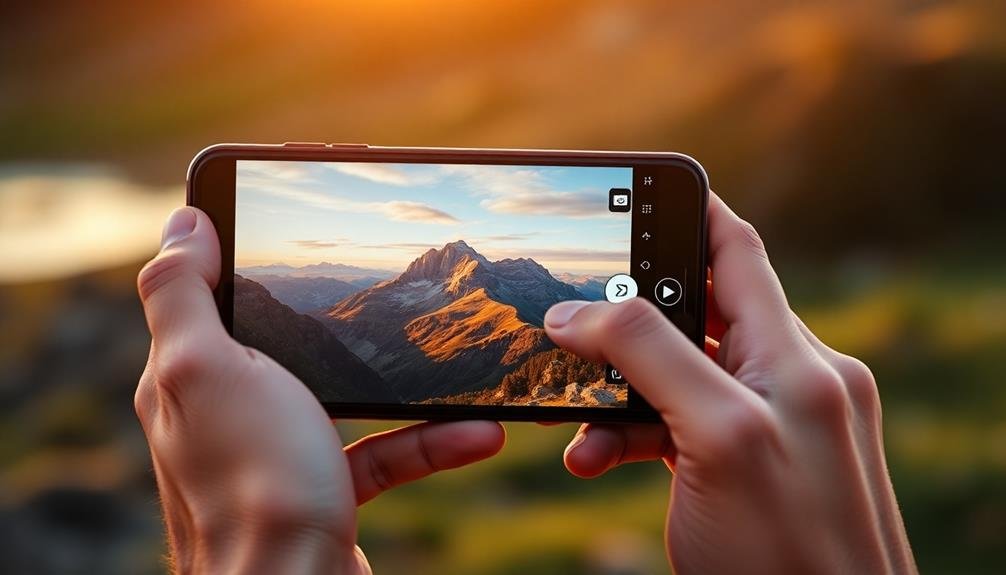
Once you've chosen the right smartphone for mobile photography, it's time to explore panoramic photography apps that can expand your creative horizons.
These apps offer advanced features and controls that go beyond your phone's built-in camera app, allowing you to capture stunning wide-angle shots with ease.
Start with Google Street View, which lets you create 360-degree panoramas and even publish them online.
For iOS users, Pano is a popular choice, offering seamless stitching and exposure compensation.
Android photographers should try Panorama 360, known for its user-friendly interface and high-resolution output.
If you're looking for more professional-grade results, consider investing in ProCapture.
It provides manual controls for exposure, focus, and white balance, ensuring your panoramas are perfectly composed.
For a unique twist, try Cycloramic, which uses your phone's vibration motor to capture hands-free panoramas.
Don't forget about editing apps like Snapseed or Adobe Lightroom Mobile.
These tools can help you fine-tune your panoramas, adjusting color, contrast, and perspective to create truly breathtaking images.
With these essential apps in your arsenal, you'll be ready to capture epic panoramic scenes wherever you go.
Mastering Composition for Panoramic Shots
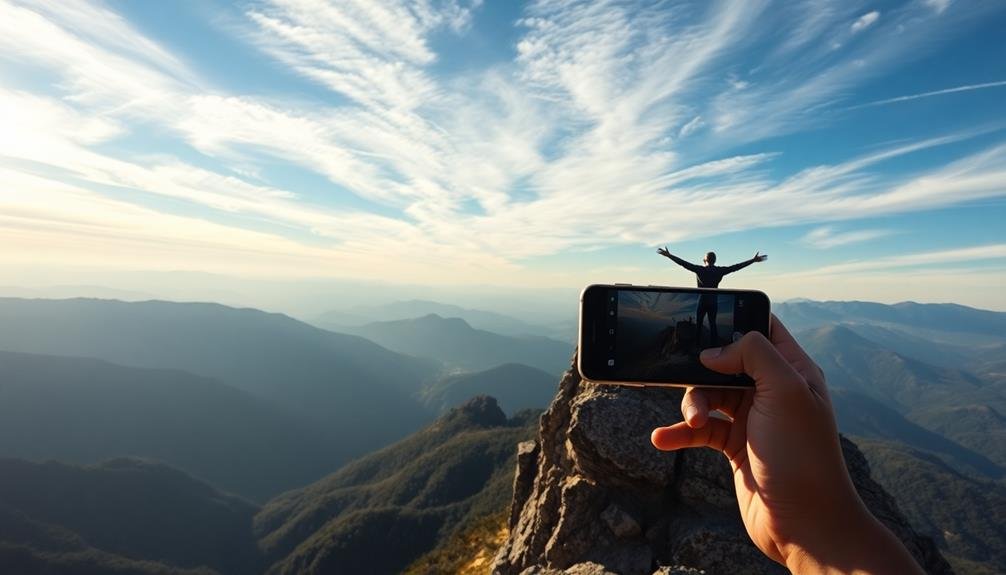
While panoramic photography apps can help you capture wide-angle shots, mastering composition is essential for creating truly stunning images. To elevate your panoramic photos, start by choosing a strong focal point that'll draw the viewer's eye. This could be a striking landmark, an interesting pattern, or an enthralling foreground element.
Consider the rule of thirds when framing your shot. Place key elements along the imaginary grid lines or at their intersections to create a balanced and visually appealing composition.
Don't forget to include foreground elements to add depth and context to your panoramas. Pay attention to leading lines, such as roads, rivers, or architectural features, that can guide the viewer's gaze through the image. These lines can create a sense of movement and perspective in your panoramic shots.
When capturing landscapes, verify your horizon is level. Slightly tilting your phone can result in distorted panoramas. Use your device's built-in level or grid overlay to maintain a straight horizon.
Capturing Motion in Panoramas
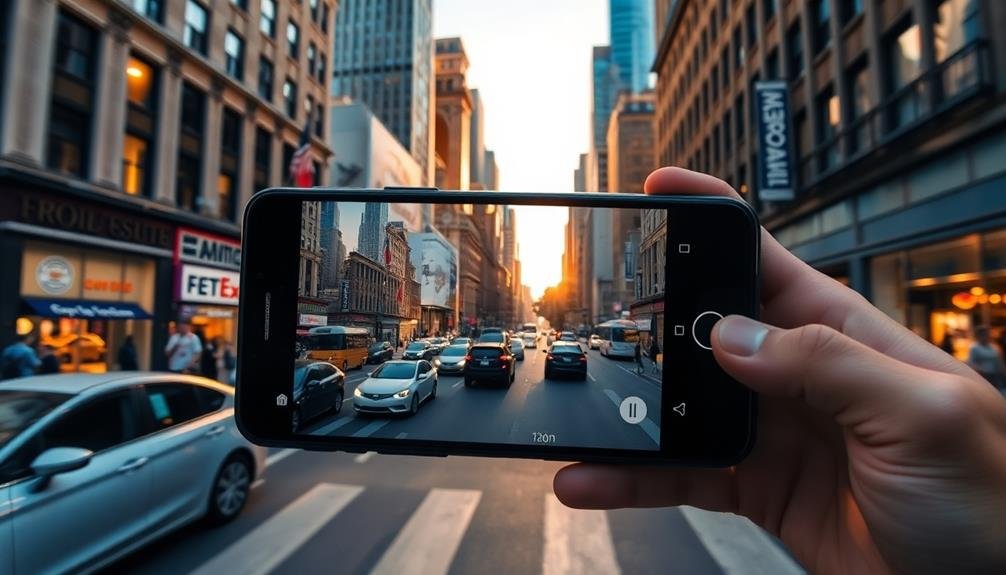
Panoramas don't have to be limited to static scenes. You can capture motion and action within your wide-angle shots, adding dynamism and life to your mobile photography.
To achieve this, start by identifying a moving subject that contrasts with the static background. This could be a cyclist, a flock of birds, or even flowing water.
When shooting, pan your phone smoothly in the direction of the moving subject. Use a slightly slower shutter speed to introduce motion blur, typically between 1/15 and 1/60 of a second. Many mobile camera apps offer manual controls for this purpose. As you pan, keep the subject in relatively the same position within your frame.
Experiment with different panning speeds and shutter speeds to find the right balance between sharp subject details and blurred background. Remember, the goal is to convey a sense of movement while maintaining the panoramic aspect.
For best results, use a mobile tripod or stabilizer to keep your horizontal movement steady. Post-processing can help enhance the motion effect by adjusting contrast and sharpness selectively.
With practice, you'll master the art of capturing dynamic panoramas that tell compelling stories of movement and action.
Lighting Techniques for Epic Results
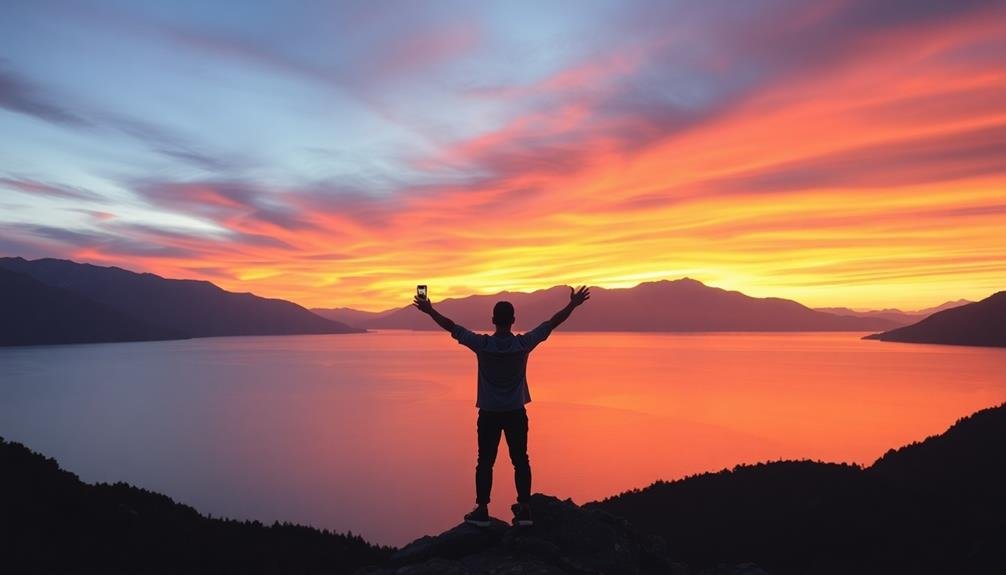
In the domain of mobile photography, mastering lighting techniques is key to achieving epic results. You'll want to harness both natural and artificial light sources to create stunning panoramas.
Start by understanding the golden hour, that magical time just after sunrise or before sunset when soft, warm light bathes your scenes. During this period, you can capture rich colors and long shadows that add depth to your images.
Don't shy away from challenging lighting conditions. Experiment with backlighting to create dramatic silhouettes or lens flares for artistic effect.
When shooting in bright sunlight, use HDR mode to balance exposure across your panorama. For low-light situations, steady your phone and use night mode to capture more detail.
Consider using external light sources like LED panels or reflectors to fill in shadows and highlight specific areas. Learn to adjust your camera's exposure compensation to fine-tune brightness.
Pay attention to white balance settings to accurately represent colors in different lighting conditions. By mastering these techniques, you'll elevate your mobile panoramas from ordinary to extraordinary, capturing epic results that truly stand out.
Stabilization Methods for Smooth Panning
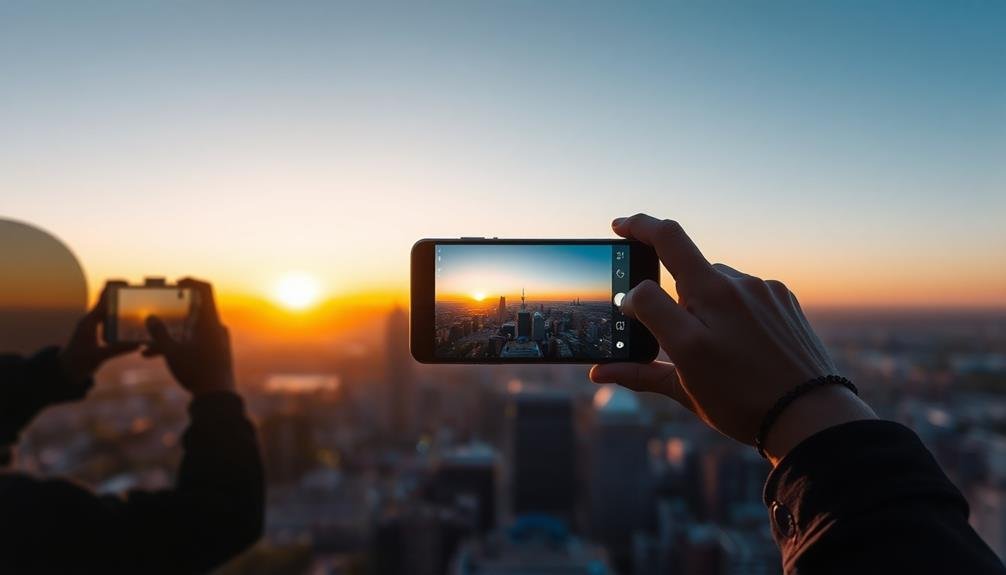
Achieving smooth panning shots can make or break your mobile panoramas. To capture fluid, professional-looking images, you'll need to master stabilization techniques. Start by holding your phone with both hands, keeping your elbows close to your body for added support. This stance creates a more stable base for your movements.
When panning, pivot from your hips rather than your arms or wrists. This larger body movement allows for smoother, more controlled motion. Try to maintain a consistent speed as you pan, avoiding sudden jerks or pauses. Practice this motion before taking your shot to get a feel for the right pace.
For even better results, consider using a mobile gimbal. These devices counteract hand shake and provide incredibly smooth panning shots. If a gimbal isn't an option, try using a makeshift stabilizer like a string monopod. Tie a string to your phone case and step on the other end, creating tension for steadier shots.
Lastly, use your phone's built-in stabilization features if available. Many modern smartphones offer optical or electronic image stabilization, which can greatly improve your panning shots.
Experiment with these techniques to find what works best for your style and equipment.
Post-Processing Panoramic Action Photos
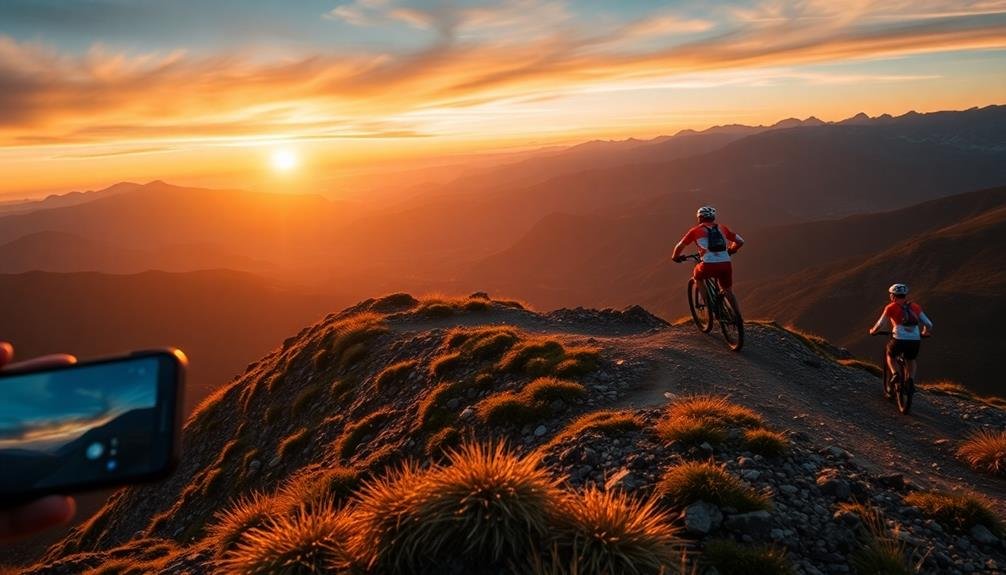
Often, capturing panoramic action photos is just the first step in creating stunning mobile images.
Post-processing is where you can truly elevate your shots and bring out their full potential. Start by selecting the best photos from your burst or continuous shooting session. Look for images that showcase the action at its peak and have the clearest focus.
Next, use your favorite mobile editing app to adjust exposure, contrast, and color balance. Don't be afraid to experiment with different presets or filters to enhance the mood of your panoramic action shot.
Pay special attention to the highlights and shadows, ensuring that details aren't lost in either the bright or dark areas.
For truly impactful panoramic action photos, consider these emotional enhancements:
- Boost saturation to make colors pop and convey energy
- Add a subtle vignette to draw focus to the central action
- Apply selective sharpening to emphasize key elements of the scene
Creative Panoramic Storytelling Techniques
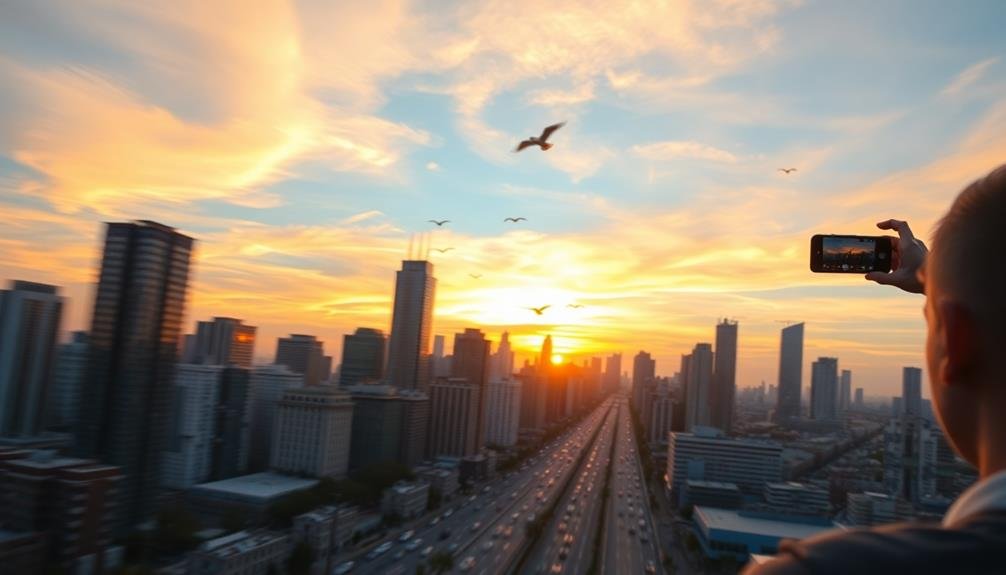
Elevate your panoramic storytelling by sequencing dynamic scenes to capture unfolding events.
You'll create a narrative flow by strategically aligning multiple shots that showcase action progression.
Blend different perspectives within your panorama to add depth and intrigue, allowing viewers to experience the story from various vantage points.
Sequencing Dynamic Scenes
In light of the dynamic nature of mobile photography, sequencing dynamic scenes offers a powerful way to tell visual stories. By capturing a series of images that unfold over time, you'll create a narrative that engages viewers and draws them into the action.
Start by identifying a subject with movement or change, like a street performer or a bustling marketplace.
As you prepare to shoot, consider these emotional elements:
- Anticipation: Build suspense by including shots that hint at what's to come.
- Climax: Capture the peak moment of action or transformation.
- Resolution: Show the aftermath or conclusion of the event.
Frame your shots carefully, maintaining a consistent perspective throughout the sequence. Use burst mode to capture rapid movement, ensuring you don't miss vital moments.
Pay attention to lighting changes and adjust your exposure accordingly. When editing, select images that best convey the story's progression and emotions. Experiment with different arrangements to find the most impactful sequence.
Blending Multiple Perspectives
Panoramic photography takes on a whole new dimension when you blend multiple perspectives. This technique allows you to create a narrative within a single, expansive image. Start by planning your shot and identifying key elements you want to include.
As you capture your panorama, deliberately change your position or angle between shots to incorporate different viewpoints. You can showcase height differences by taking some shots from a low angle and others from a higher vantage point.
Experiment with including both close-up details and wider views to add depth to your panorama. Don't be afraid to move around objects or include dynamic elements that change over time.
When editing, carefully align and blend your images to create a seamless yet multifaceted panorama. Pay attention to shifts between perspectives, using gradual changes or creative overlaps to maintain visual flow.
You can also play with the order of your shots to create an interesting visual journey across the final image. This technique works particularly well for urban scenes, landscapes with varying elevations, or events with multiple focal points.
Common Mistakes to Avoid
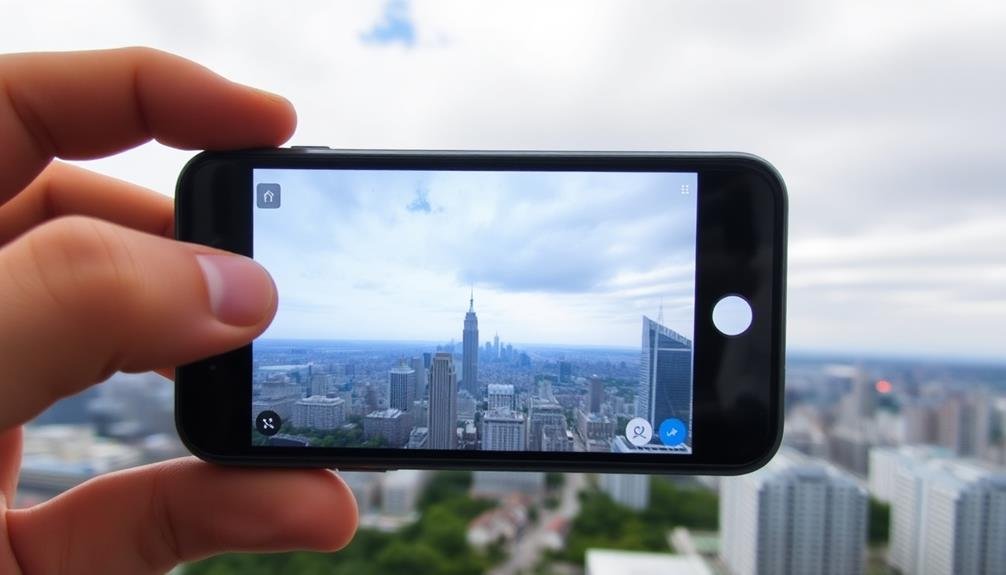
As you venture into mobile photography, you'll want to steer clear of common pitfalls that can hinder your progress.
Watch out for shaky hands and blurry shots, which can ruin otherwise great photos, and be mindful of poor composition techniques that detract from your image's impact.
Don't forget to take into account lighting conditions, as they play a vital role in determining the quality and mood of your mobile photographs.
Shaky Hands, Blurry Shots
One of mobile photography's biggest enemies is camera shake, resulting in blurry, unusable shots. Your hands are naturally unsteady, and even the slightest movement can ruin an otherwise perfect photo. To combat this issue, you'll need to adopt proper techniques and utilize your phone's built-in features.
First, hold your phone with both hands and keep your elbows tucked close to your body for added stability. If possible, lean against a solid object or rest your arms on a stable surface. When pressing the shutter button, use a gentle touch to avoid jerking the device.
Many smartphones offer image stabilization features, so make sure to enable them in your camera settings. Additionally, use your phone's timer function or voice commands to trigger the shutter without touching the screen.
For challenging low-light situations, consider these emotional appeals:
- Frustration: Don't let shaky hands rob you of capturing precious memories.
- Excitement: Imagine the crisp, professional-looking photos you'll take with steady hands.
- Pride: Feel confident in your ability to capture stunning images in any situation.
Poor Composition Techniques
While mastering steady shots is important, your mobile photography skills won't shine without proper composition. Many mobile photographers fall into common traps that can ruin otherwise great shots. One frequent mistake is centering your subject, which often leads to static, uninteresting images. Instead, try using the rule of thirds to create more dynamic compositions.
Another pitfall is failing to contemplate the background. You might be focused on your subject, but cluttered or distracting backgrounds can detract from your main focus. Take a moment to scan the entire frame before shooting.
Overlooking leading lines is another missed opportunity. Look for natural lines in your environment that can guide the viewer's eye through your image. Ignoring the edges of your frame can result in awkward cut-offs or unwanted elements creeping in. Always check your frame's borders before pressing the shutter.
Overlooking Lighting Conditions
For many mobile photographers, lighting remains an overlooked aspect of capturing great images. You might've the perfect composition, but if you're not paying attention to the light, your photos will fall flat. Natural light can make or break your shot, so it's essential to understand how it affects your subject.
Don't assume that bright, midday sun is ideal for photography. In fact, it often creates harsh shadows and washed-out colors. Instead, aim for the golden hours – just after sunrise or before sunset – when the light is soft and warm.
If you're shooting indoors, position your subject near a window to take advantage of natural light.
To evoke emotion in your audience, consider these lighting techniques:
- Use backlighting to create a dreamy, ethereal effect
- Capture dramatic shadows for a moody, mysterious atmosphere
- Experiment with side lighting to highlight textures and contours
Frequently Asked Questions
How Do I Handle Extreme Temperature Conditions While Shooting Panoramic Photos?
When shooting panoramas in extreme temperatures, you'll need to protect your gear. Keep your phone warm in cold weather and cool in hot conditions. Use gloves, insulated cases, and shading techniques to maintain peak functionality.
Can I Create Panoramas Using Multiple Smartphones Simultaneously?
Yes, you can create panoramas using multiple smartphones simultaneously. It's a challenging technique, but it'll allow you to capture wider scenes faster. You'll need to synchronize your devices and use specialized apps for stitching the images together.
What's the Best Way to Protect My Phone During Action Panorama Shoots?
To protect your phone during action panorama shoots, you'll want to invest in a rugged case and screen protector. Don't forget a sturdy grip or strap. Consider using a waterproof pouch if you're near water or in dusty conditions.
Are There Any Legal Considerations When Capturing Panoramic Shots in Public Spaces?
When taking panoramic shots in public spaces, you'll need to be aware of privacy laws. Don't capture people without consent, respect private property, and avoid photographing sensitive areas. Always check local regulations before shooting to avoid legal issues.
How Can I Incorporate Aerial Perspectives Into My Mobile Panoramic Photography?
You can incorporate aerial perspectives in mobile panoramic photography by using a drone, finding elevated viewpoints, or attaching your phone to a tall monopod. Don't forget to check local regulations and prioritize safety when capturing from heights.
In Summary
You've now got the tools to create stunning panoramic action shots with your smartphone. Remember to experiment with different apps, perfect your composition, and master motion capture techniques. Don't forget about lighting and stabilization for the best results. With post-processing skills and creative storytelling, you'll elevate your panoramas to new heights. Avoid common pitfalls, and you'll be capturing epic, sweeping scenes that'll leave viewers in awe. Go out and start shooting!

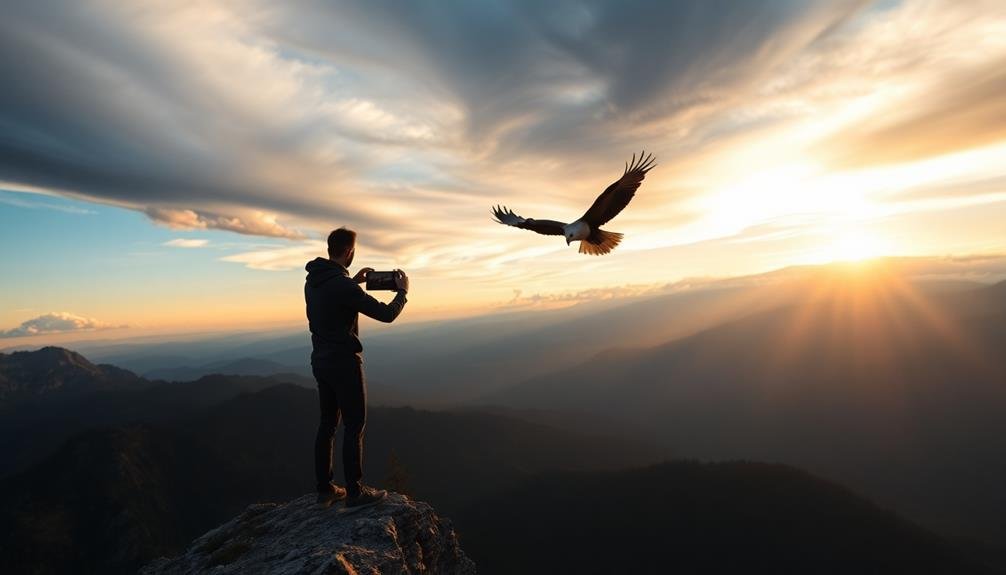



Leave a Reply